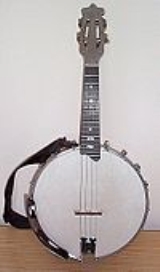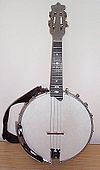
Banjolin
Encyclopedia
The three instruments described below are named "banjolin". It should not be mistaken for the mandolin-banjo
, nor is it to be confused with the Banjoline
.
 The Banjolin is a name applied to several different types of stringed instruments:
The Banjolin is a name applied to several different types of stringed instruments:
Mandolin-banjo
The mandolin-banjo should not be mistaken for the banjolin , though their names are sometime interchanged. The mandolin-banjo is also known by its French name, "banjoline", but should not be confused with the Banjoline designed by Peabody. The manjo is also a popular nickname for the...
, nor is it to be confused with the Banjoline
Banjoline
The Banjoline is a type of electric guitar developed by Eddie Peabody in conjunction with Rickenbacker. Although its name suggests a combination of banjo and mandolin, it is technically considered to be a type of plectrum guitar, a variant of the electric guitar, resembling the banjo and mandolin...
.

- A "banjolin" is a type of 4 string banjoBanjoIn the 1830s Sweeney became the first white man to play the banjo on stage. His version of the instrument replaced the gourd with a drum-like sound box and included four full-length strings alongside a short fifth-string. There is no proof, however, that Sweeney invented either innovation. This new...
, pitched in the same register as a mandolin popularized in the 1920s. It is tuned and played the same as a mandolinMandolinA mandolin is a musical instrument in the lute family . It descends from the mandore, a soprano member of the lute family. The mandolin soundboard comes in many shapes—but generally round or teardrop-shaped, sometimes with scrolls or other projections. A mandolin may have f-holes, or a single...
.
- The major difference it has from a Mandolin is a 10.5- to 11-inch banjo-body which serves to amplify the instrument relative to a standard mandolin (especially important in the days before widespread electric amplificationAmplifierGenerally, an amplifier or simply amp, is a device for increasing the power of a signal.In popular use, the term usually describes an electronic amplifier, in which the input "signal" is usually a voltage or a current. In audio applications, amplifiers drive the loudspeakers used in PA systems to...
).
- The banjolin has 4 strings (as opposed to the mandolin and mandolin-banjo which have 4 coursesCourse (music)A course is a pair or more of adjacent strings tuned to unison or an octave and usually played together as if a single string. It may also refer to a single string normally played on its own on an instrument with other multi-string courses, for example the bass string on a nine string baroque...
). The scale length and tuningMusical tuningIn music, there are two common meanings for tuning:* Tuning practice, the act of tuning an instrument or voice.* Tuning systems, the various systems of pitches used to tune an instrument, and their theoretical bases.-Tuning practice:...
are identical to the mandolin (low to high: GDAE).
- The instrument was designed for use in banjo orchestraOrchestraAn orchestra is a sizable instrumental ensemble that contains sections of string, brass, woodwind, and percussion instruments. The term orchestra derives from the Greek ορχήστρα, the name for the area in front of an ancient Greek stage reserved for the Greek chorus...
s. Later it appeared occasionally in jug bands. It is now rare; current prices range from about 200 to 700 of U.S. dollarsDollarThe dollar is the name of the official currency of many countries, including Australia, Belize, Canada, Ecuador, El Salvador, Hong Kong, New Zealand, Singapore, Taiwan, and the United States.-Etymology:...
.
- A "banjolin" is a type of banjo, the 'younger brother' of the tenor banjo. Banjo hybrids normally take their names from the Banjo- prefix, and then the second half of the other instrument's name, such as banjocello and the banjitar, which has led to the belief that the banjolin is a sort of Mandolin/Banjo hybrid. The Banjolin is actually a 'violin banjo'. Fretless banjolins are therefore more likely to crop up. Banjolins should not be confused with the Banjo UkuleleBanjoleleThe banjolele is a four-stringed musical instrument with a small banjo-type body and a fretted ukulele neck. "Banjolele," sometimes also spelled "banjelele" or "banjulele" is a generic nickname given to the instrument, which was derived from the "banjulele-banjo", introduced by Alvin D...
(UkuleleUkuleleThe ukulele, ; from ; it is a subset of the guitar family of instruments, generally with four nylon or gut strings or four courses of strings....
), due to their larger head size and shorter scale length in comparison.
- A "banjolin" is a type of banjo patented by John Farris in 1885, available then in sopranoSopranoA soprano is a voice type with a vocal range from approximately middle C to "high A" in choral music, or to "soprano C" or higher in operatic music. In four-part chorale style harmony, the soprano takes the highest part, which usually encompasses the melody...
, altoAltoAlto is a musical term, derived from the Latin word altus, meaning "high" in Italian, that has several possible interpretations.When designating instruments, "alto" frequently refers to a member of an instrumental family that has the second highest range, below that of the treble or soprano. Hence,...
, tenorTenorThe tenor is a type of male singing voice and is the highest male voice within the modal register. The typical tenor voice lies between C3, the C one octave below middle C, to the A above middle C in choral music, and up to high C in solo work. The low extreme for tenors is roughly B2...
, and bassBass (voice type)A bass is a type of male singing voice and possesses the lowest vocal range of all voice types. According to The New Grove Dictionary of Opera, a bass is typically classified as having a range extending from around the second E below middle C to the E above middle C...
models, all either "quartette" (four-string) or "quintette" (five-string) (see external link below).
- A "banjolin" is a type of bowedBow (music)In music, a bow is moved across some part of a musical instrument, causing vibration which the instrument emits as sound. The vast majority of bows are used with string instruments, although some bows are used with musical saws and other bowed idiophones....
fretless zitherZitherThe zither is a musical string instrument, most commonly found in Slovenia, Austria, Hungary citera, northwestern Croatia, the southern regions of Germany, alpine Europe and East Asian cultures, including China...
(see fretFretA fret is a raised portion on the neck of a stringed instrument, that extends generally across the full width of the neck. On most modern western instruments, frets are metal strips inserted into the fingerboard...
and external link below).
External links
- The Banjolin Page
- An advertisement for Farris's banjolin.
- Bowed instruments at fretlesszithers.com

